
Hi, I’m Gaurav Kapoor
a Consultant. Solution Designer. Creative Leader. Musician. Traveller.Portfolio
Digital transformation
Currently heading the digital transformation practice at my company. We are developing Machine Learning based applications for utilities
Performance Enhancement
Successfully lead and delivered on 10+ complex assignments aimed at technical and commercial loss reduction in DISCOMs
Strategy & Quality
Lead the strategy and quality teams as Head (Improvement) in Tata Steel Utilities & Services Ltd. Also developed business strategy for a Nigerian client recently
Learning & Development
Developed roadmap for capacity building for DISCOMs in India. Conducted market study and content development for a power training institute in Africa.
Smart Grid
Conducted feasibility studies, prepared project reports and conducted key performance parameter baselining for smart grid projects in eastern India. Experience of working with IT / OT in the power distribution sector in India
Technical due diligence
Undertaken techno commercial due diligence for franchisee and licensee transactions - more than 5 projects across India
Project showcase
Restructuring and performance enhancement in an Integrated Utility near South Africa
Integrated ratings for power DISCOMs
Integrated ratings for Indian Power DISCOMs is conducted by Power Finance Corporation (PFC) every year. Usually, the exercise is conducted by the rating agencies CARE and ICRA. In 2021, this work was assigned to a consortium of Feedback Infra and another consulting firm. I was responsible for executing the assignment from Feedback Infra’s side.
Techno-commercial due diligence of 2 union territories
Undertaken and successfully completed two projects for different clients to evaluate the ‘go-no-go’ decision.
Consulting services to enhance vocational training in an African country
My Resume

TekUncorked AIIoT Pvt. Ltd.
VP - Smart Grids
Formulating and driving the Strategy, new product development and innovation

RTI International
DISCOM Specialist
Spearheaded the bid process management and DPRs for Smart Distribution, Monitoring and evaluation of DISCOM modernisation projects in South Asia

Feedback Infra
Lead Consultant
Leading the digital transformation practice to develop machine- learning based applications for power sector & Oversee execution of consulting (advisory) assignments
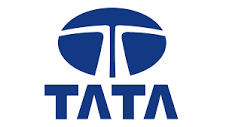
Tata Steel Utilities and Infrastructure Services Limited
Head Billing & Improvement
Headed the utility billing and quality department (Electrical) of Jamshedpur township of Tata Steel covering 80,000 power and water consumers. Municipal and utility services of Jamshedpur are managed by TSUIL (formerly JUSCO Ltd.). I served 3 years as Head (Billing) and 3 years as Head (Improvement).

Enzen Global
Dy. Project Manager
Responsible for creating Centre of Excellence for Metering. Execution of franchisee projects in MP and Odisha states. Improvement in billing by more than 15% from baseline resulting in revenue enhancement by INR. 19 Cr.

Noida Power Company Ltd.
Executive - Operations
Responsible for SAP (IS-U) device management module, HT / LT metering including AMR and billing as well as substation construction (5 MVA 33 / 11 kV), Energy Audits etc.
Professional education
eEPOM - Operations Management
Indian Institute of Management, KozhikodeIIM - Kozhikode is one of the prestigious Indian B-schools of the IIM cadre. My specialisation was in Operations Management wherein I learnt about important concepts such as BPR, lean and six-sigma. I cherish the moments spent on-campus interacting with the likes of Prof. Pati and Prof. Debashish.
BE in Electrical Engineering
Dibrugarh University, Assam, IndiaJorhat engineering College (JEC) is affiliated under Dibrugarh University and is one of the premier Engineering institutes in Northeast India. My specialisation was Extra High Voltage under Prof. C. Sahu and HoD Prof. Deven Mohanta.
Secondary education
Higher Secondary - Science
Assam Higher Secondary Education CouncilHigher Secondary education in Science was fun at the Swadeshi Academy in Guwahati, Assam. Here, I was coached by stalwart professors late Dr. Mohan Borah and Dr. Nareshwar Sharma.
Matriculation
Secondary Education Board of AssamDuring my formative years, I was fortunate enough to be educated in a co-ed environment. My school, Sudarshan Public School (erstwhile Disneyland) was one of the best in the city. My childhood in this school left a lasting impression on me and my personality as well as my world view.
Recent Certificates
Data Science Professional
SpringpeopleIn this course I learnt about data science, its usage, terms like machine learning and AI. I got a primer on data analytics using R - software and lots of pointers for further study in this field.
Tata Affirmative Action Program
Tata Quality Management ServicesThe Tata group has a legacy of engagement with the disadvantaged sections of society dating back to its founding fathers. Tata companies have CEO-led Affirmative Action (AA) committees to decide AA strategy and oversee the implementation of the programmes. This certification is for qualification as external assessor to companies’ AA initiatives and modelled on the Tata Business Excellence Model.
Mobile Application Development
Engineering Staff College of IndiaThis was an interesting course on app development using standard tools such as Android Studio platform. I learnt JavaScript and the standard android SDK. Further studied about Material design concept and cross platform development.
Older Certifications
Tata Business Excellence Model
Tata Quality Management ServicesI secured Gold level position in the TBEM assessment model which made me eligible to become an external assessor to other Tata Group Companies. During my tenure, I assessed two Tata Group Cos.
QMS Internal Auditor
ISTD, JamshedpurLearnt the tricks of the trade in Quality Management Systems by Professor Ranjit Ram. This course ramified my interest in quality and made me apply for the post of Head (Improvement) which I eventually secured.
Advanced course in Metering
YMPL, Secure Meters Ltd.This is a regular course conducted by YMPL (subsidiary of Secure Meters Limited). The course invites engineers from distribution and transmission companies from all over India.
Awards for performance
Stellar Performance award
Feedback InfraStellar performance award for successfully completing an advisory project for Government of India.
Significant contribution award
Feedback InfraThis was awarded for significant contribution across multiple projects.
My interests and hobbies
Software development
• Front-end User interface development using Flutter / Android Studio / VS Code • Proficient in website development using Content Management Systems • Working knowledge of machine- learning-based application design in Python • Proficient in cloud platform deployment, webservices and APIs
Audio-Visual design
• Adept in creating audio-visual content such as educational videos, slideshows, etc. (Was responsible for creating AV for UDAY scheme which was showcased before Hon’ble Power Minister) • Adept in music mixing and mastering with industry recognized software such as ProTools and Logic Pro
Other hobbies
• Singing and playing guitar • Blogging • Travelling • Learning new languages (Currently can communicate in 5 languages)
My Blog
Rebranding the Rot: A Corporate City with a Civic Crisis
From traffic lights that teach patience to ten-year-olds doing MBAs in street survival, Gurugram is a masterclass in contradiction. A

Rebranding the Rot: A Corporate City with a Civic Crisis
A Name steeped in Truth (and Other Substances)
In Assamese, Gurgaon (pronounced Goo-r Gaon) quite literally translates to “a village full of shit.” And every now and then, I find myself wondering — was this a prophecy in disguise?
Because honestly, it’s not too far from the truth.
Filth in Gurgaon isn’t a nuisance. It’s an omnipresent design feature. Every corner comes with its own curated garbage mound—some seasonal, some permanent. Sewer lines bubble over with quiet rebellion. Like slow-cooked revenge, turning the streets into olfactory battle zones.
And yet, the city offers its residents a unique, rare privilege: the chance to live in a garbage bin the size of Singapore, thoughtfully garnished with glass-clad towers. A perfect marriage of decay and aspiration. Urban planning meets post-apocalyptic chic.
Next time someone says “Gurgaon is developing fast,” do take a moment to ask: “Into what?”
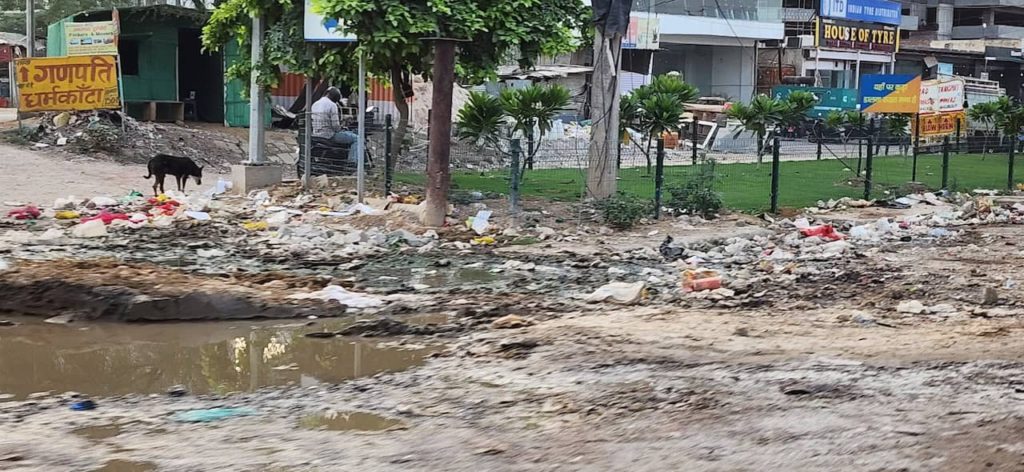
Gurgaon’s Holy Rebranding
The political overlords of this so-called city weren’t sitting idle. No sir. They reached deep into India’s beloved bag of urban development tricks—and pulled out the holy grail of good governance: a name change.
And so, Gurgaon became Gurugram.
The logic, of course, was impeccable. After all, if it worked for Madras, Bombay, and Allahabad, why not try some etymological sorcery here too?
Faced with kilograms of historic pride, the city’s very own piles of garbage began their miraculous transformation—into metaphorical gold. Or so the story goes.
That’s what residents tell themselves every night, curled up in their multi crore-rupee condos. Windows shut tight to keep out the stench, ears shielded from the 24/7 symphony of honks, and overlooking a skyline that’s best viewed with filters. Instagram filters. Juno. Clarendon. Anything but reality.
But hey, at least the name now has “Guru” in it. That has to count for something.
Spiritual growth, maybe.
Or perhaps just spiritual resignation.

A Traffic Light Opera
Each morning, as I wait at the traffic light, Guru-gram offers yet another masterclass in urban absurdity.
A cacophony of horns in every possible pitch fills the air. Vehicles crawl ahead a few inches—just enough to generate a sense of false hope—before the light turns red again.
Progress, as they say, is subjective.
Overlooking this mechanical mayhem is a faded, dust-coated signboard, proudly reminding everyone that they are in #SmartGurugram—lest anyone forget that amidst the honks, heat, fumes and stench.
As my cab lumbers across the intersection, a few traffic policemen come into view—uniforms soaked, faces weathered, tightly gripping handheld challan machines like heat-stricken Jedi knights. Keeping order in the chaos. Right out of Maxwell’s demon thought experiment.
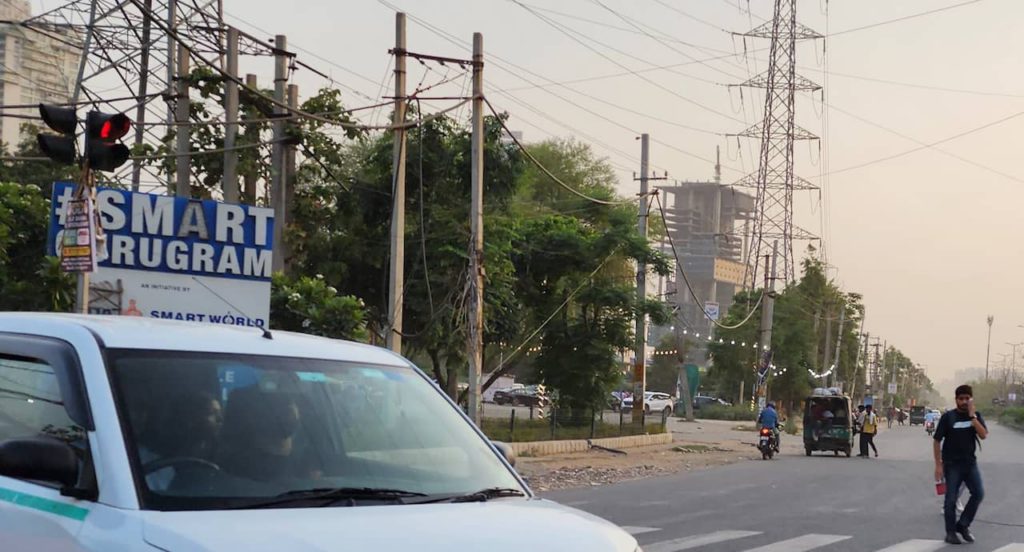
Lessons from the Guru
On the sidewalk, a few street urchins hover—ragged pens in hand, hope in their eyes. They are not picky. Ten rupees for a pen or ten rupees for pity—either transaction would do.
Survival, too, is subjective. Because in Gurugram, even empathy is monetized.
A boy—barely ten—approaches a hulking SUV and taps on the tinted glass. The window remains rolled up. The AC hums inside, oblivious.
Maybe he should have been in school.
But no—he’s lucky. He’s learning from the Guru.
Not in a classroom, of course. That would be too cliché for Gurugram. This is hands-on learning. Real life. Real hustle.
His syllabus includes traffic signals, windshield wiping, strategic begging, advanced negotiation with indifferent adults, and real-time rejection handling. An MBA in survival.
Perhaps he is Eklavya?
Seems to be. Thumbs up!
Except here, there’s no Dronacharya to deny him an education.
Because here—no one even notices him.
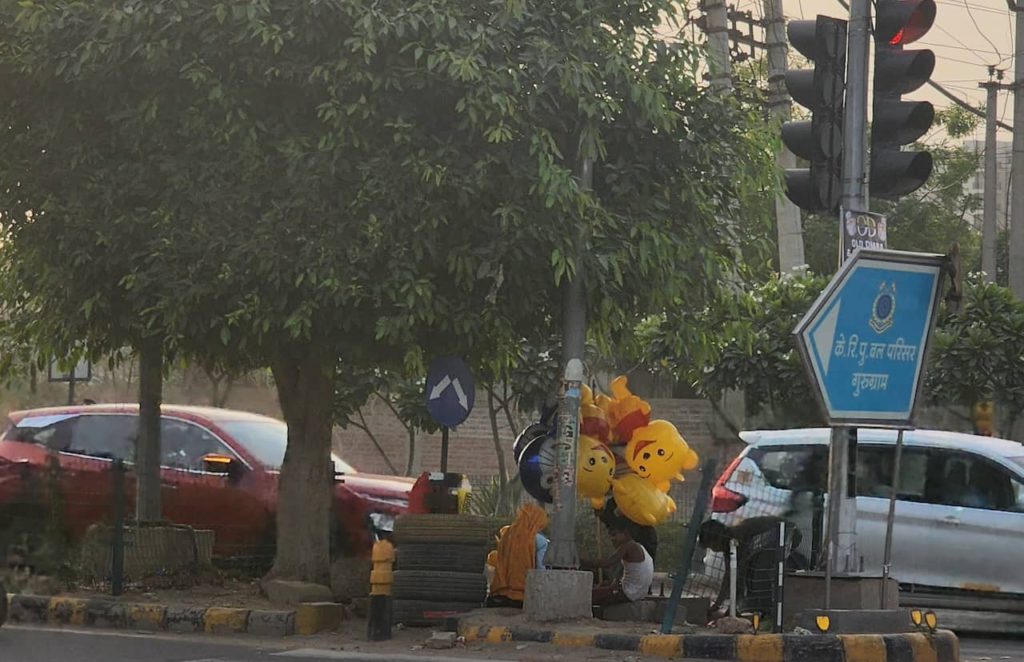
And Then Came the Rain…
And just when you think Gurugram has given you everything—potholes, posh cafés, and philosophical trauma—it rains.
Not a monsoon. Not a downpour. Just 15 minutes of respectable drizzle. Enough to drown entire sectors.
Basements turn into underground swimming pools. Cars begin their amphibious journeys. Residents, now trapped indoors, spend their time documenting this on WhatsApp groups:
“Hi, anyone else’s drawing room floating?”
“Guys, please avoid Golf Course Road—it’s currently a tributary of the Yamuna.”
“Bro, the ducks are back in Sector 57.”
Hope, Floating
And yet, despite the water-logged roads, power outages, and mosquito armies, there’s something bizarrely beautiful about this city.
Maybe it’s the people. The mad, ambitious, air-purifier-owning dreamers.
The ones who pay crores to live in towers that flood, traffic that stands still, and air that tastes like diesel.
They still believe.
They still stay.
They still smile for selfies next to waterlogged Audis.
Because if there’s one thing Gurugram teaches you—it’s resilience.
Or denial.
Or both.
But maybe, just maybe, when the waters recede and the sewage retreats, a better city might emerge.
Stronger. Cleaner.
Or at least better at pretending.
Until then, keep your umbrellas ready, your filters strong, and your sarcasm sharper.
Not Fired, You’re Just ‘Let Go’
Ever been gently "let go" by your employer? Discover the artful euphemisms corporations use to sugarcoat layoffs, turning professional gut

Not Fired, You’re Just ‘Let Go’
In recent corporate news, Zomato compassionately “let go” of 600 customer support employees, citing a slowdown in food deliveries and a shift toward automation. Not to be outdone, Ola Electric announced plans to gracefully shed 1,000 employees, while Hewlett Packard Enterprise, not wanting to miss out on the corporate euphemism trend, gently “released” 2,500 workers to offset declining profits.
“Let go”
In today’s fast-paced corporate world, language evolves faster than you can say “performance review.” Enter the phrase “let go,” the hottest euphemism burning up corporate jargon these days. Ah, “let go”—a phrase so tender it evokes images of releasing injured wildlife lovingly back into their natural habitat.
Gone are the crass days of “firing” or “termination,” replaced with a term so gentle it sounds like releasing a rehabilitated baby bird back into the wild. Never mind that the “wild” here translates to the brutal jungles of unemployment, laden with LinkedIn invites, generic rejections, and meetup dinners that never quite taste like success.

Picture the scene: You’re in a sterile conference room, seated opposite Sheila Webb from HR, whose empathetic smile barely masks the discomfort of delivering someone else’s harsh decision. Poor Sheila, the reluctant bearer of corporate doom, armed only with empathetic nods and a reheated smile. She leans forward gently and whispers:
“We’re going to have to let you go.”
For a brief, bewildered moment, you wonder if you’ve been kidnapped, perhaps trapped in some corporate-themed escape room. Let me go? Was I held captive all this time? Have I unknowingly been chained to my cubicle for years? Have the shackles of employment finally been unlocked?
The transformation of firing
“Letting go” now comes cloaked in mindfulness, painted as a Zen-like release into spiritual liberation. But let’s be clear—this spiritual awakening is forced by companies that once frantically hired like Black Friday shoppers grabbing discounted televisions. Executives, drunk on the promise of limitless growth, made wild staffing decisions with all the careful planning of a toddler let loose in a candy store.
HR managers, mere instruments wielded by shadowy corporate overlords, now speak in hushed, Zen-like tones:
“We’re just letting you go…freeing you from your daily bondage to explore the infinite possibilities of unemployment.”

But let’s be honest. Being “let go” doesn’t exactly come with the gentle nudge it promises. In reality, it’s more like being hurled off a financial cliff with a “good luck” parachute stitched together by unpaid bills and LinkedIn connection requests from people you barely remember. It implies agency, as though you’re being set loose from a cage of responsibilities to frolic joyously in the meadows of opportunity. Never mind that those meadows are filled with job applications and awkward conversations about employment gaps. In most of those conversations you end up feigning enthusiasm for roles requiring “five years of experience in technology invented two years ago.”
One big family
Ironically, these announcements often follow company-wide emails proclaiming: “We’re one big family!”. That too just before mandatory team-building retreats where everyone awkwardly pretends they’re not on a corporate Titanic headed straight for an iceberg. The message is clear: families stick together—at least until quarterly earnings reports dictate otherwise.
This corporate-speak has become so comforting, you almost look forward to your next firing—I mean, letting go. Maybe they’ll even add a few more euphemisms for good measure: “We’re setting you adrift,”. Or perhaps, “We’ve chosen to grant you professional independence.” It’s almost poetic. Except poetry doesn’t usually come with a box for your personal belongings and security escorting you gently out the front door.
Chin up !
But fear not! As you walk to your cab with your desk cactus and “World’s Best Employee” mug tucked under your arm, remember—you’re not jobless, you’re liberated! You’re free to follow your passion, assuming your passion involves eating instant noodles and frantically networking on LinkedIn.
So here’s to you, corporate masterminds everywhere, masters of compassionate ambiguity. Keep letting people go—after all, nothing screams company culture like softening a professional gut-punch with gentle language. And to all those who’ve been “let go”: congratulations! Your cage is open; just watch your step on the way out.
A rainy day at Mittenwald
Mittenwald is a small village in southern Germany, close to the Austrian border. Its famous Lüftlmalerei paintings make this village

A rainy day at Mittenwald
Mittenwald is a small village in southern Germany, close to the Austrian border. Its famous Lüftlmalerei paintings make this village look like a scene just out of a fairy-tale book. Mittenwald derives its historical importance from the 14th century cathedral of St. Peter and Paul located at the village center.
Rains, delays and umbrellas
We were excited about visiting Mittenwald even before our trip had started. Online searches we made in the past month showed marvelous images and we were looking forward to the third day of our trip to Austria.
You can understand, therefore, our plight when we woke up to overcast weather in Innsbruck. Ravi had already checked the weather app. Mittenwald too would be facing a sharp drizzle – we may have to delay our start a little. I dialed the reception of our hotel to find out if we could borrow umbrellas for the day. “Of course you can. I will keep 5 umbrellas ready for you. You can collect them before you leave.” I thanked Franka, the front office manager for her consideration and excellent service. “Let’s get ready and meet for breakfast at 8:00.”
At the breakfast table, Kanchan looked outside the glass windows. “Each minute it seems to be raining harder than before.” Everyone was visibly upset about the delayed start. It meant we would have to cut back on the time we would spend sightseeing.
The itinerary plan for Mittenwald
After we had settled down for breakfast, Ravi began his pep talk. “Technically Mittenwald is in Germany – but we don’t require any other document to visit there as our Schengen visa covers Germany.”
“So we will start from the Innsbruck station and cross Seefeld to Mittenwald.” he continued. “We will do some sightseeing and grab some lunch in Mittenwald. Time permitting, we would drop in at Seefeld on our way back to Innsbruck for some shopping.” he looked at each of our expressions. Ravi is the one practical person one should really have on such occasions. Always rational, terse, and pragmatic.
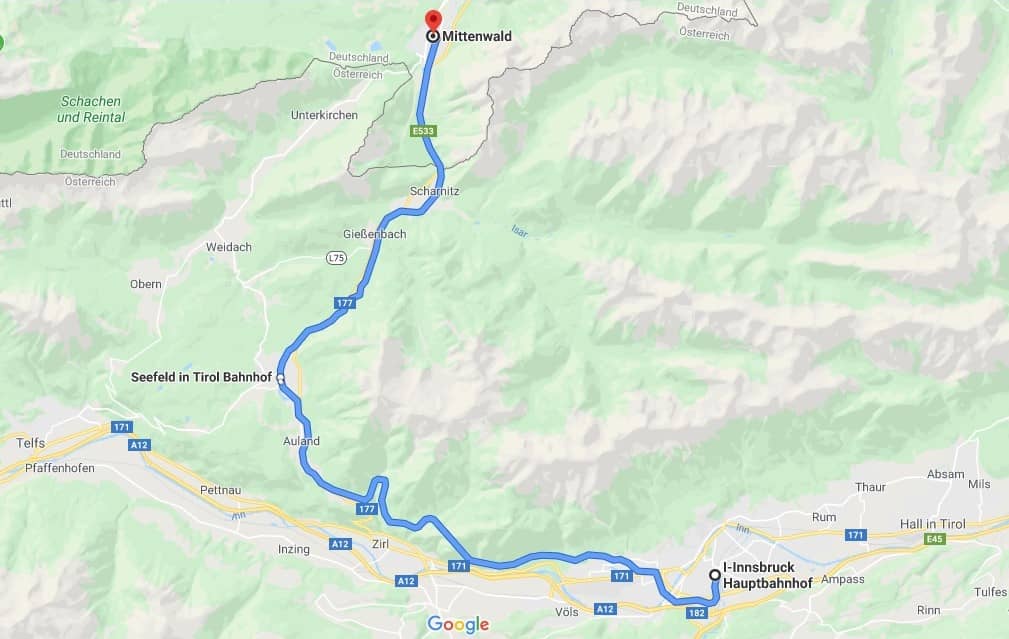
“I got a call from the Pension owners at Zell Am See. They are expecting us at around 8:00 PM.” said Ravi. “Which means we need to collect our bags from Trend hotel by say 5:00?” asked Meghna. Ravi nodded in affirmation.
The prospects of our visiting Seefeld looked bleak. Why does it have to rain in the middle of our trip?
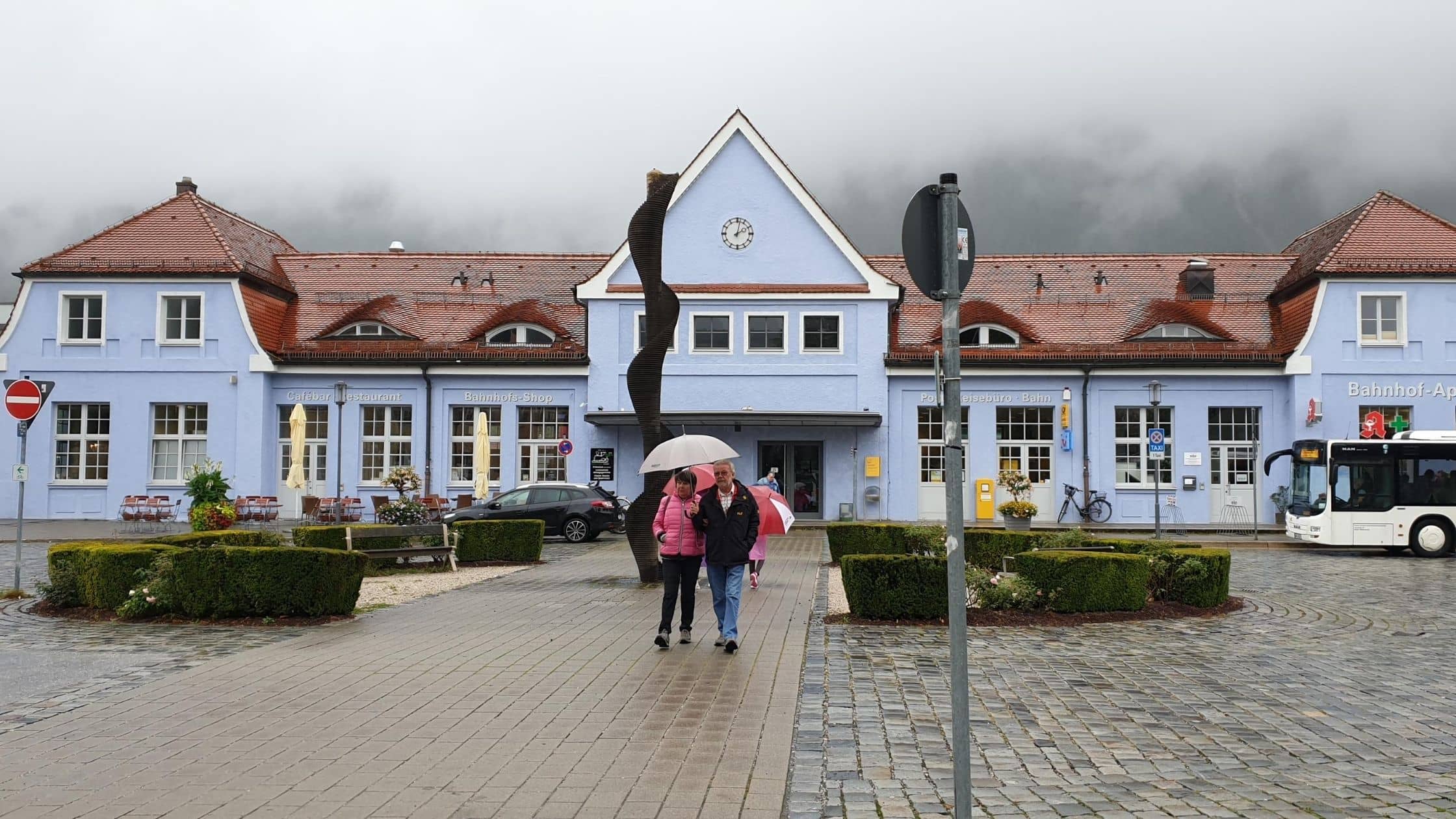
Free coupons and some hope
By 9:30 the heavy downpour had reduced to a drizzle and we hurriedly deposited our bags at the Trend hotel reception. Franka helped us with the loan of umbrellas and we all thanked her again. “You have complementary coupons that you can use at the bar. You can use it now or once you are back.” she smiled. That was the second time she had reminded us. Hotel services in these parts are extraordinarily friendly and customer-centric. “Thanks so much, Franka, we will use them in the evening once we come back to collect the luggage.”
We hurriedly crossed the street and boarded the bus for Innsbruck Hauptbahnhof. Thankfully there wasn’t any traffic that day. Maybe everyone was enjoying the rains from the cosy confines of their homes. We finally managed to catch the 10:30 train to Mittenwald. There was still hope for the fulfillment of our plan.
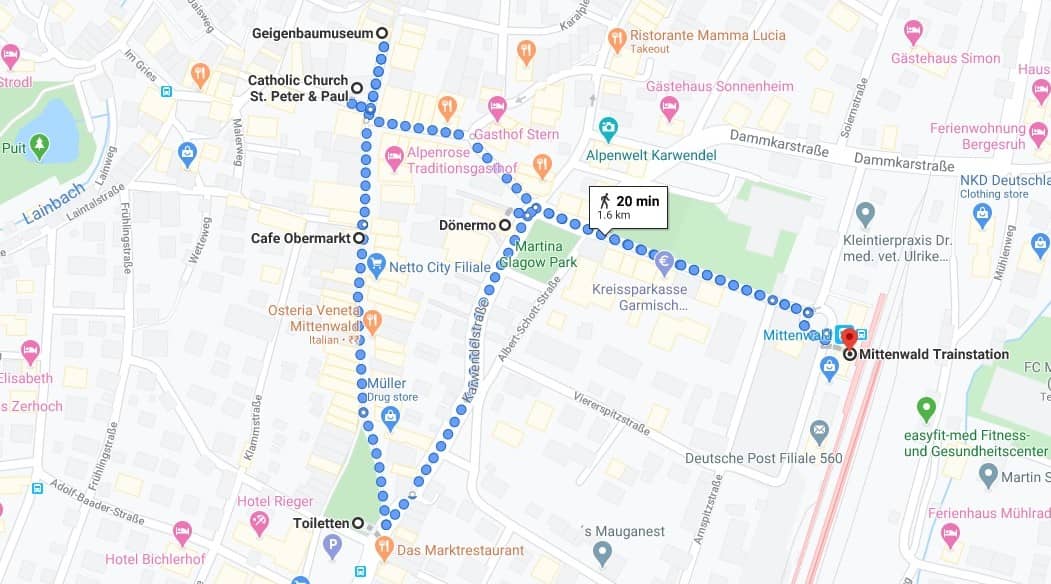
Mittenwald Bahnhof
The 100-year-old train station at Mittenwald is probably the first of the stations in German territory after the train crosses the Austrian border. No additional documents are required to enter Germany, as Ravi had explained earlier. The Schengen visa covers 26 countries, almost all of Europe so you can hop on the Eurail and practically travel anywhere it takes you. Provided you have a valid ticket of course.
It was drizzling as we stepped out on the Bahnhof Platz (square outside the station). Armed with our borrowed umbrellas, we headed out on the Bahnhof Strasse towards the famous Obermarkt near St. Peter and Paul’s cathedral.
Saint Peter and Paul’s cathedral
The street was wet from the steady drizzle, but everyone around was comfortably walking with their umbrellas raized over their heads to avoid getting drenched. As we walked admiring the wall art (Lüftlmalerei) on both sides of the street, the steeple of Saint Peter and Paul’s cathedral was visible in a distance. It is said that this imposing structure has lived the test of time since the 14th century. The church has presided over Mittenwald’s iconic Obermarkt ever since. The current incarnation of the church, however, was renovated and re-built in the 18th century.
The frescos and wall paintings are amazing and extraordinarily lively. We were contemplating a visit inside but the service was on and we didn’t want to disturb the devotees. Besides, time was short and there were too many attractions to cover. So we turned left towards the Obermarkt Strasse.
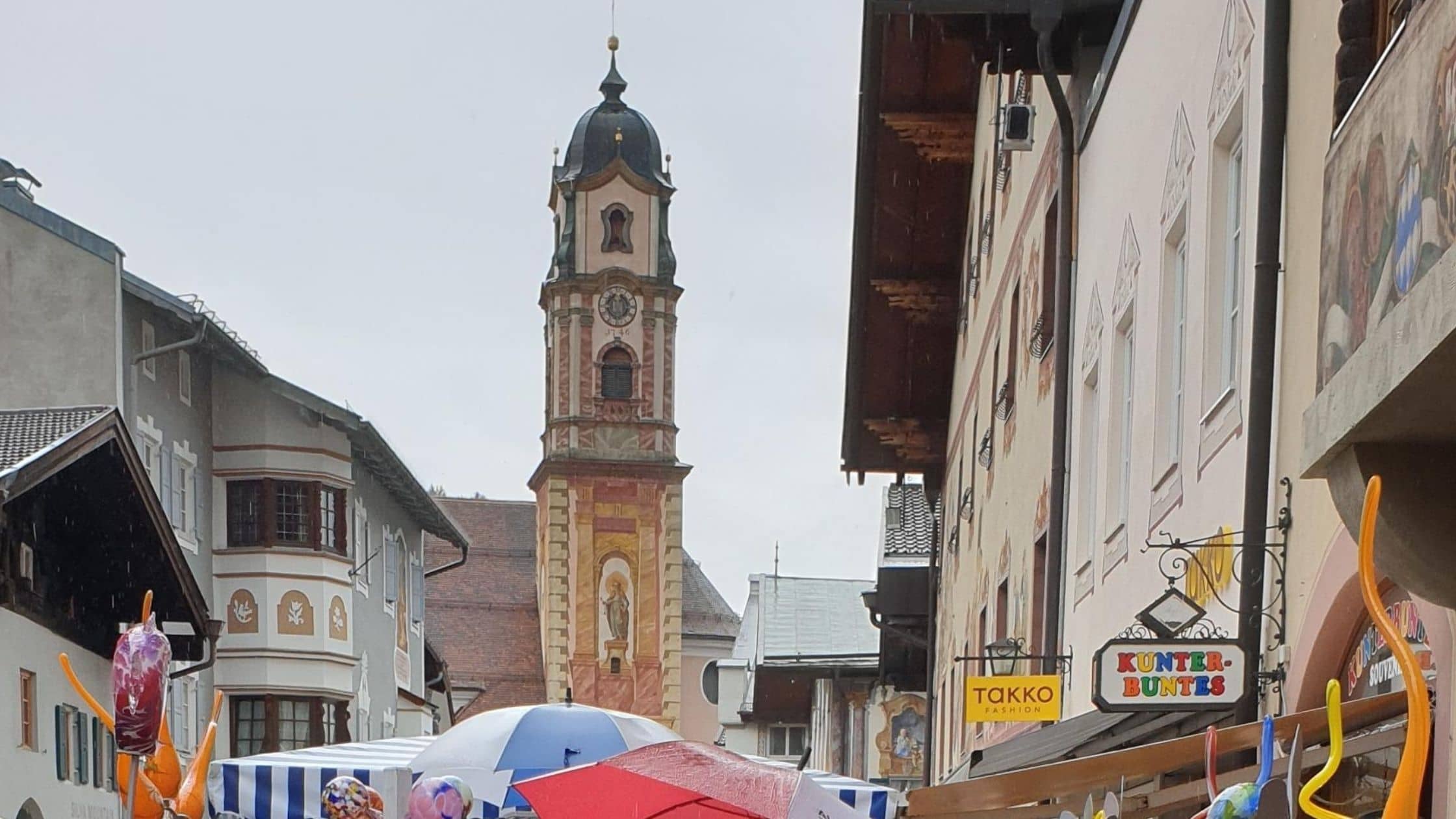
Fairy land
As we made that turn into Obermakt street, a host of colors greeted us. The entire street was oozing of charm and beauty. Parts of the street echoed with the violin concertos of Mozart. We passed by Glaserei Wörnle, an interesting glass shop in Obermarkt. A variety of colorful glass toys were displayed and naturally, children were very attracted to them. Both Sara and Meghna were delighted. There were glass frogs, dragons, elves, rabbits, owls, birds of all sorts, and a thousand other animals straight out of a fairy tale book. There were other shops too – clothes, apparels, shoes – all themed in a seemingly fairytale fashion.


Lüftlmalerei art of Mittenwald
The charm and grandiose of Mittenwald is magnified by Lüftlmalerei wall art all across the small village. It is a kind of mural painting wherein the paintings are affixed on walls with wet plaster. As the plaster dries up, the paintings become seamlessly glued to the wall making them resilient against weather changes. This makes Lüftlmalerei paintings last longer. These exquisite paintings have an impeccable 3-D effect, perfectly crafted with shadows and elevations at the right places.
Some of the paintings show biblical figures. But a vast majority of them depict the Bavarian lifestyle during the medieval period. The protagonists are mainly knights, craftsmen, astronomers, and the whole lot from the middle ages. Very intricate and interesting to observe closely. You will be surprised to learn that some of them are actually more than 200 years old. Meghna and I could go on admiring the paintings for a full day when suddenly someone tugged at us. “Coffee break?” asked Kanchan with a grin.
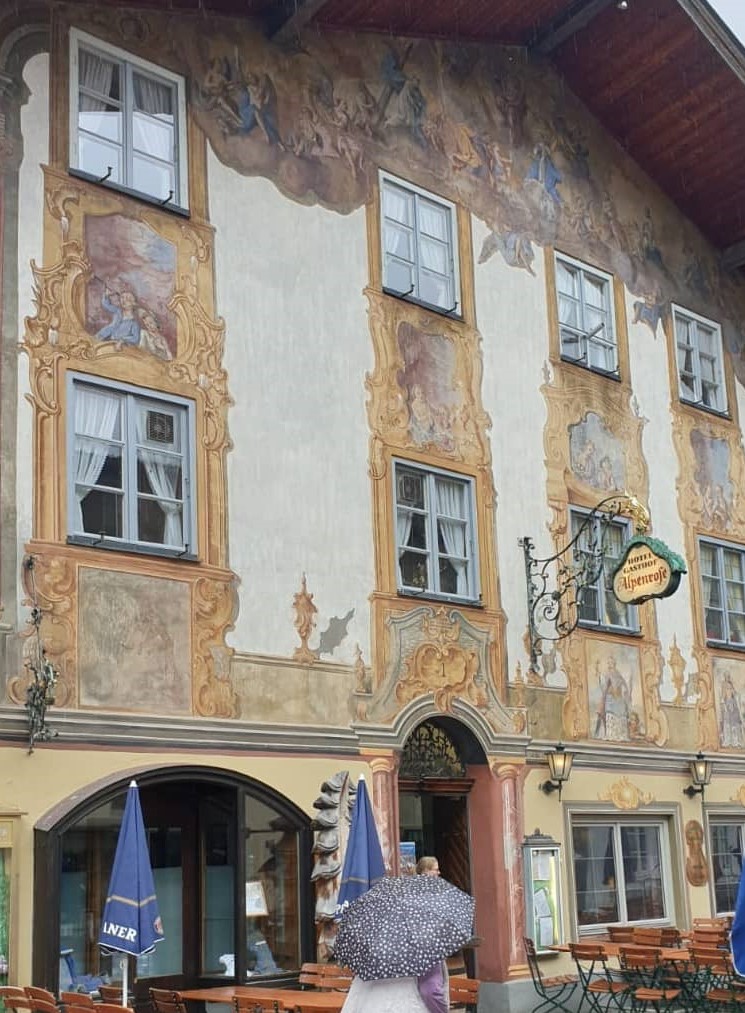
Short break for coffee
For those who are planning a trip anywhere in Europe, I would advise you to indulge profusely in beer, cheese, wine, coffee, and even hot chocolate. This you should be doing frequently at every location possible because each place leaves a different after-taste. Life in these parts is much about good food and a lot of beer – so why not indulge?
In the case of friendly neighborhood Mittenwald, we submitted ourselves to the good facilities of Cafe Bozner. Going by the aroma around that place we knew we couldn’t go wrong. Besides I wanted to listen to the entire piece playing that time.
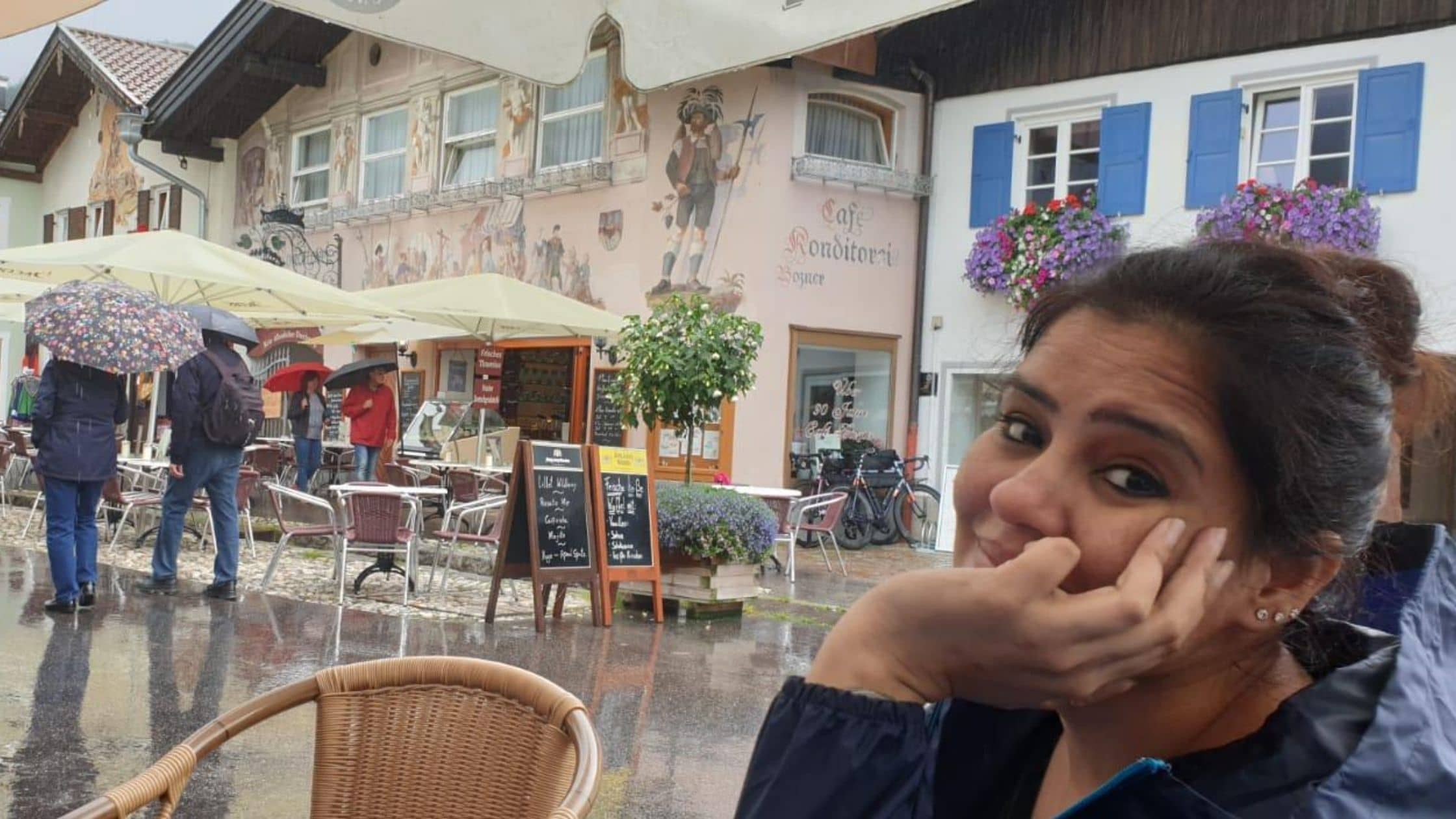
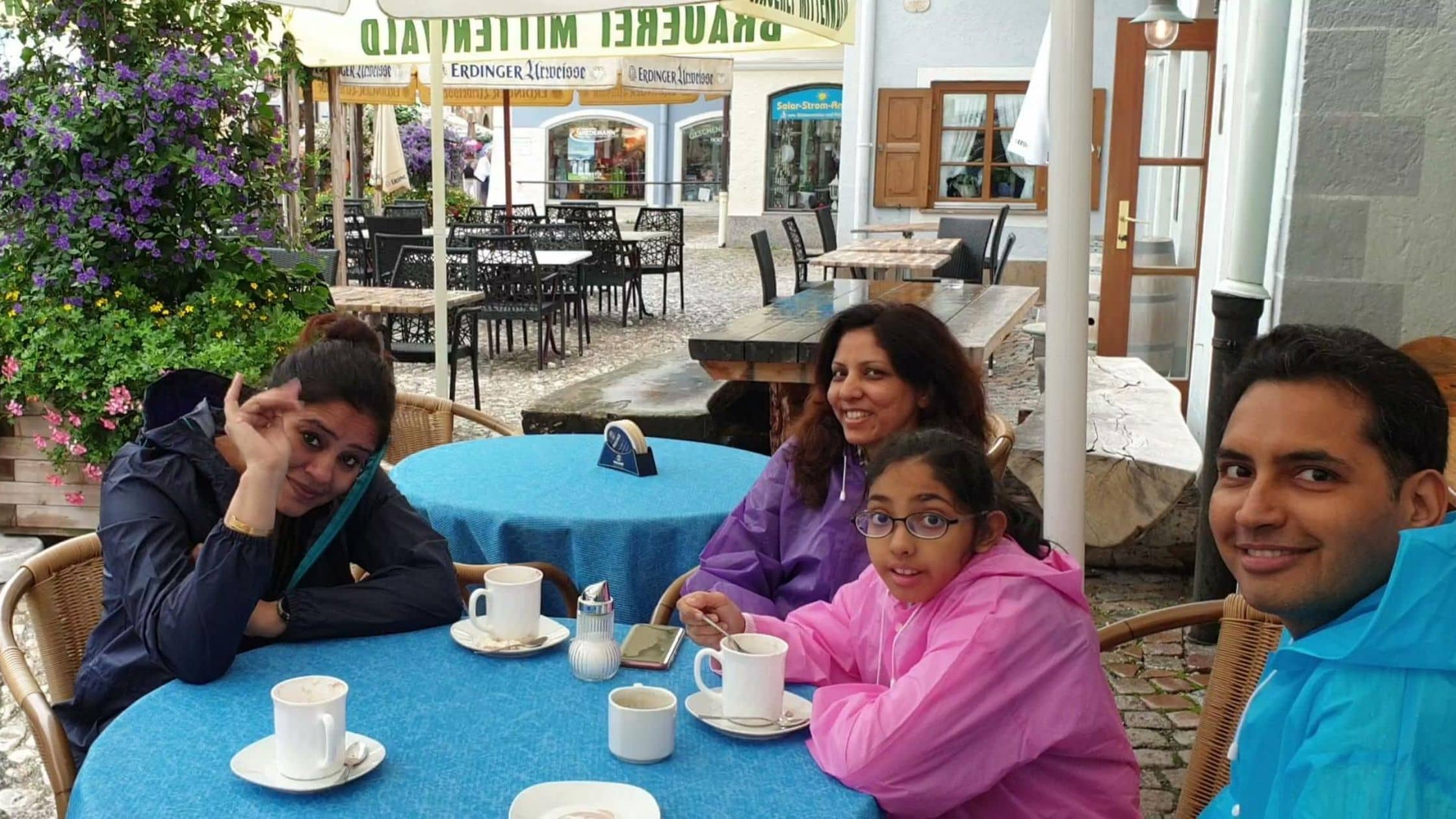
Cute doggies and Gemütlichkeit
I was delighted to find that people in these parts are out and out dog lovers. One out of three people had a leach in hand. The culture of keeping pets immaculately manicured and brushed is ingrained in the Bavarian region and surrounding areas. Later I witnessed the same during our onward trip to Salzburg, Vienna, and Zell Am See.
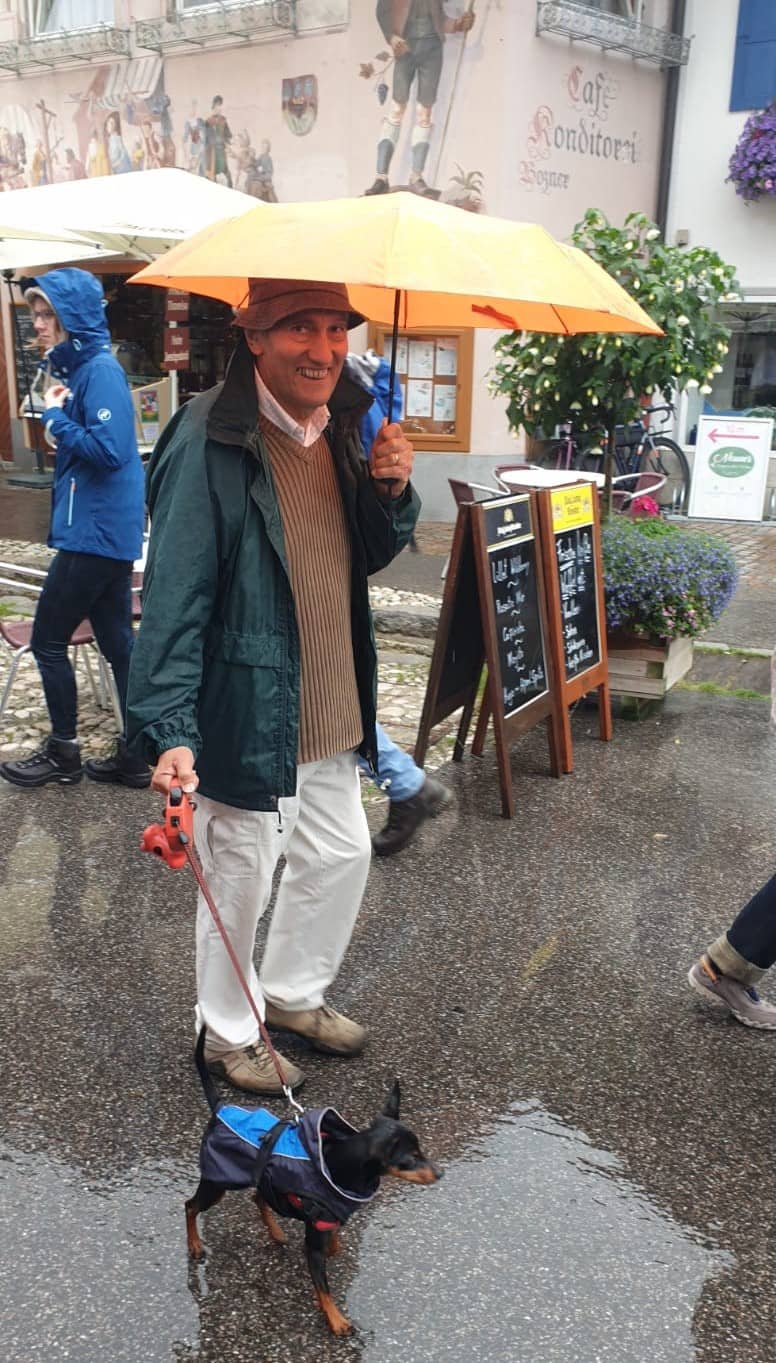
Over coffee, we made some small talk with the extremely polite lady in charge of the services at the cafe. Most people in these parts are comfortable in English with varying degrees of fluency but that hardly posed any problems for us at all. And yes, people are wonderfully polite – unlike what they tell you about Germans. We never came across anybody rude.
“Here in these areas, there is a culture of Gemütlichkeit you know – it means friendliness.” She paused, seemingly struggling to find another word, but carried on in her thick German accent. “People love to live a calm, easy-paced life.” She looked at each one of us in turn as if about to reveal a secret. “Not like the ones in Berlin !” and she broke into laugher. Kanchan laughed with her for a while so did some of us while. Clearly, none of us got the joke. She didn’t expect us to. She was a good soul carrying out her job with a smile.
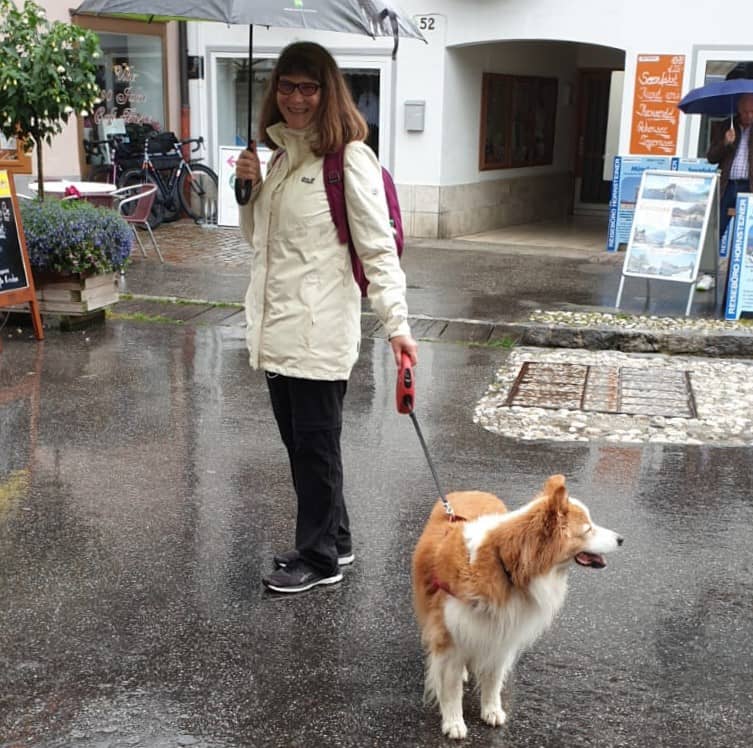
Let’s relive our childhood
Soon after, we were back on the street. The rain had subsided. Nevertheless, due to the weather, I guess, there were fewer tourists on the street. On a positive note, the streets looked sexier because of the rain as well as the scanty crowd. Maybe some were attending the church service. But we didn’t see as many children in this fairyland as one would have imagined. Firstly, the area is quite thinly populated, and second, the population appears to be more skewed towards the elderly, not only in Bavaria but in the overall Austrian region as well.
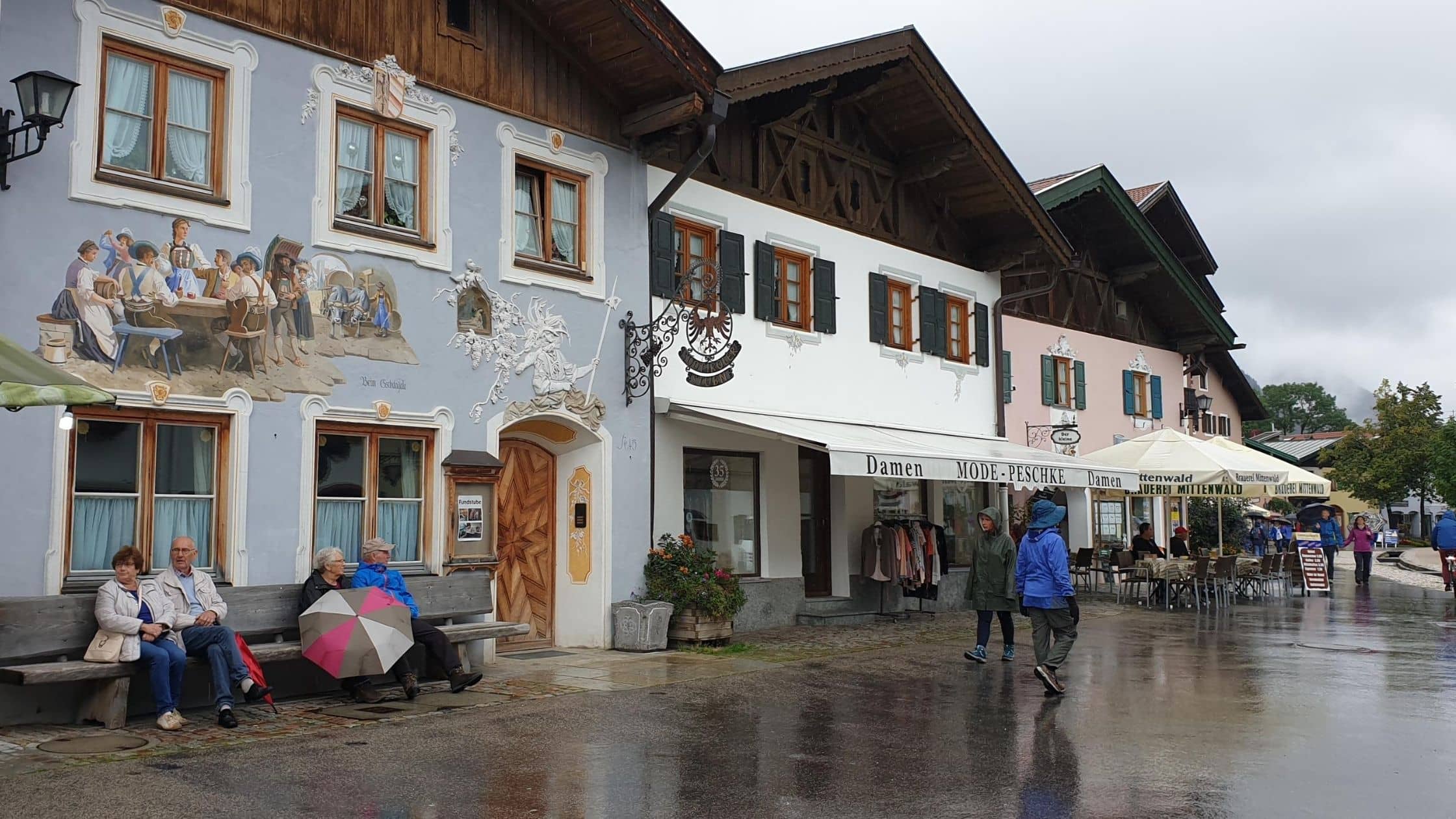
As time passed by while we wandered on the Obermarkt street, I pondered over the matter and came to the conclusion that Mittenwald must be frequented by the elderly so that they can experience being a child again. Maybe so. But our trip did not go without a friendly tryst with a child and a first hand at Gemütlichkeit as you shall see soon. But before that, I need to give you some background about the famous Klotz family of Mittenwald.
The Klotz family of violin makers
Legend has it that in the 17th century, there lived a famous violin maker (called Geigenmacher in German) by the name of Mathias Klotz. Klotz had learnt the art of violin making in Italy and had returned to Mittenwald and opened a workshop here. Soon his violins became famous for their craftsmanship and quality – further enhanced by his son and grandson.
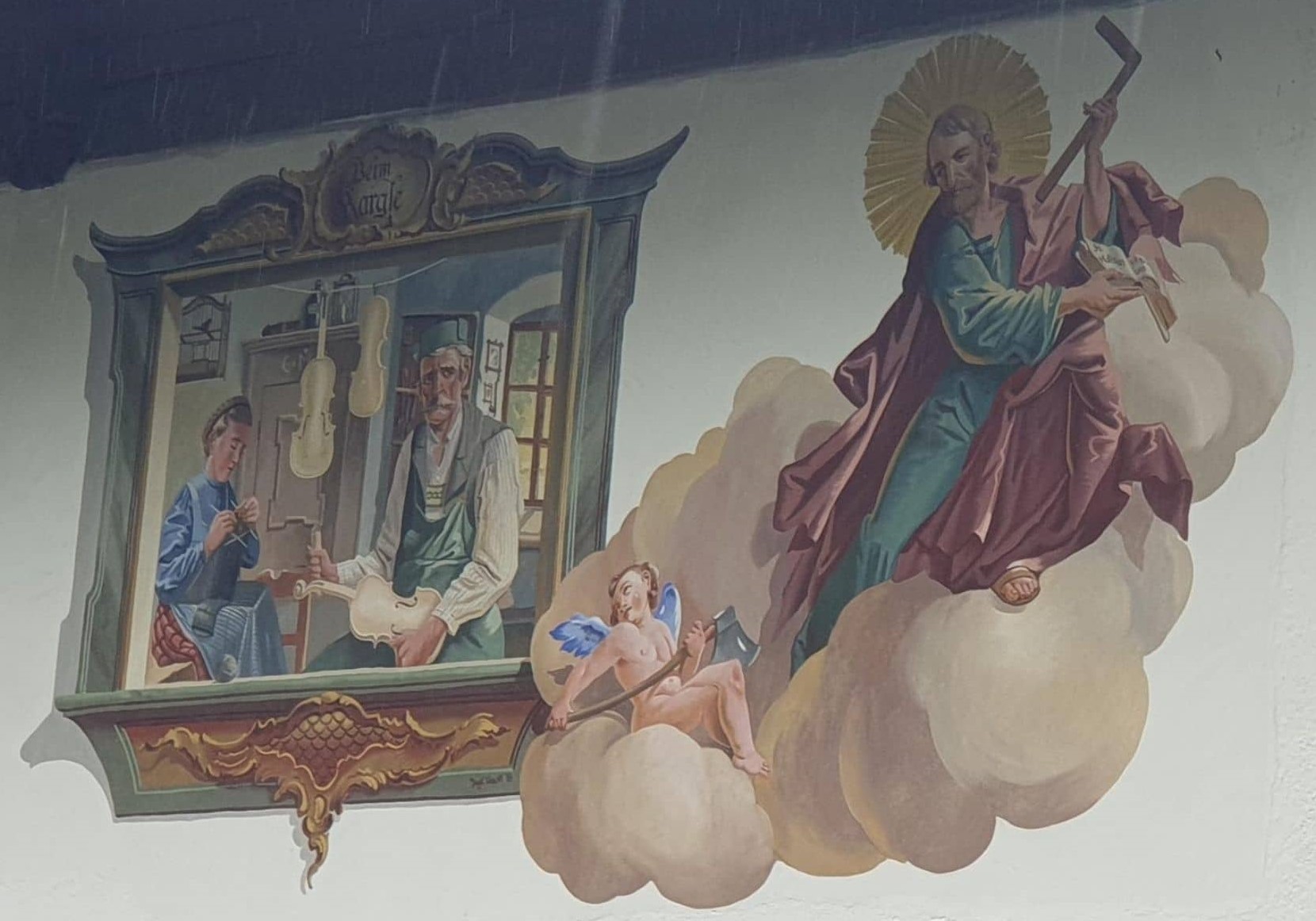
The Klotz family has since then handed down their craft from generation to generation. There is a wonderful museum called the Geigenbaumuseum dedicated to this legacy near Saint Peter and Paul’s cathedral.
At the souvenir shop, we saw a number of mementos depicting Mathias Klotz and his violins showing how his name is revered and loved even today. It was at this souvenir shop that I had the most joyous experience of German friendliness surpassing anything else I had witnessed before.
The souvenir shop


Let’s lunch

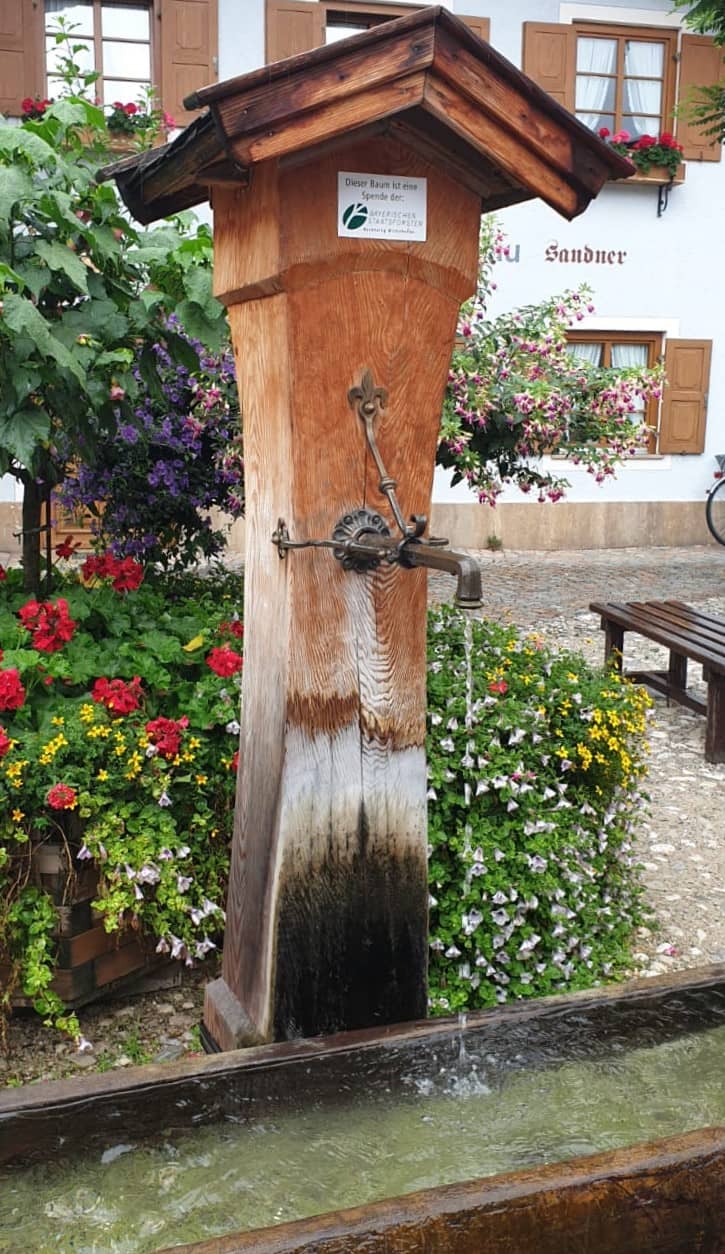
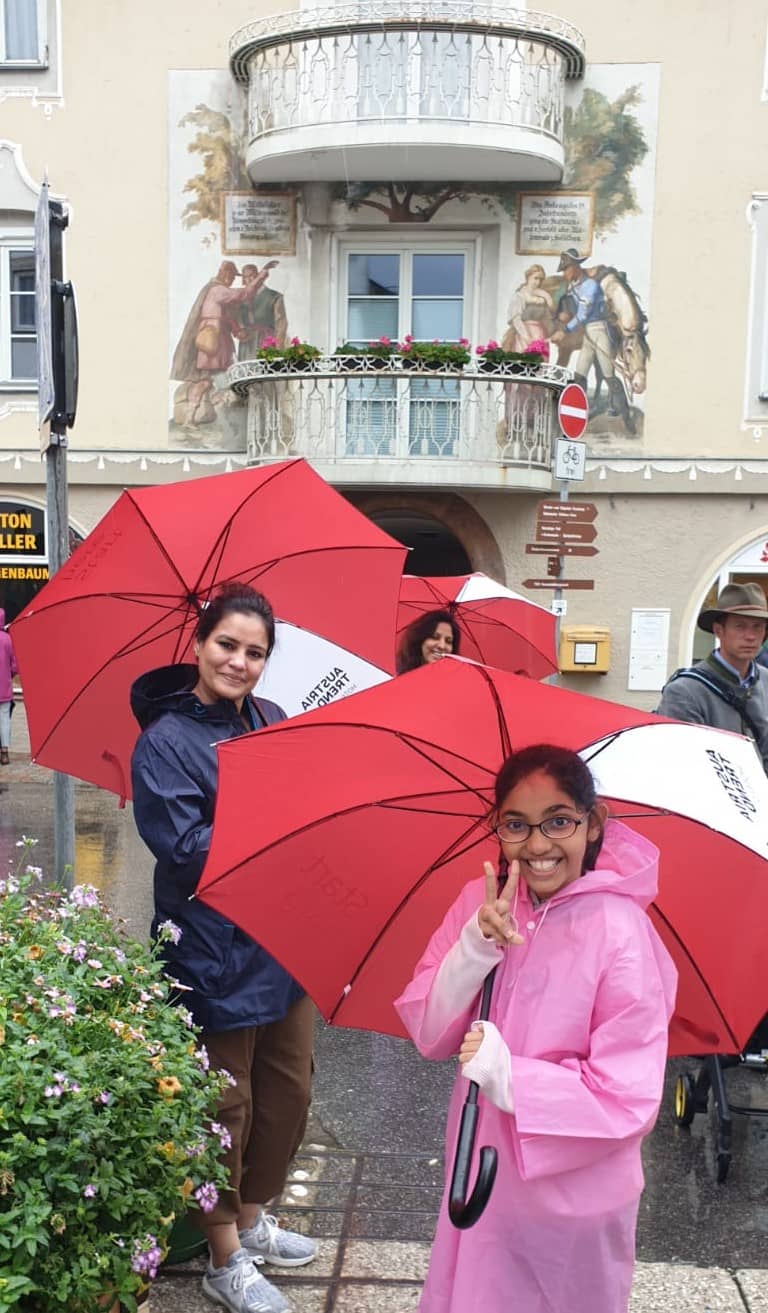
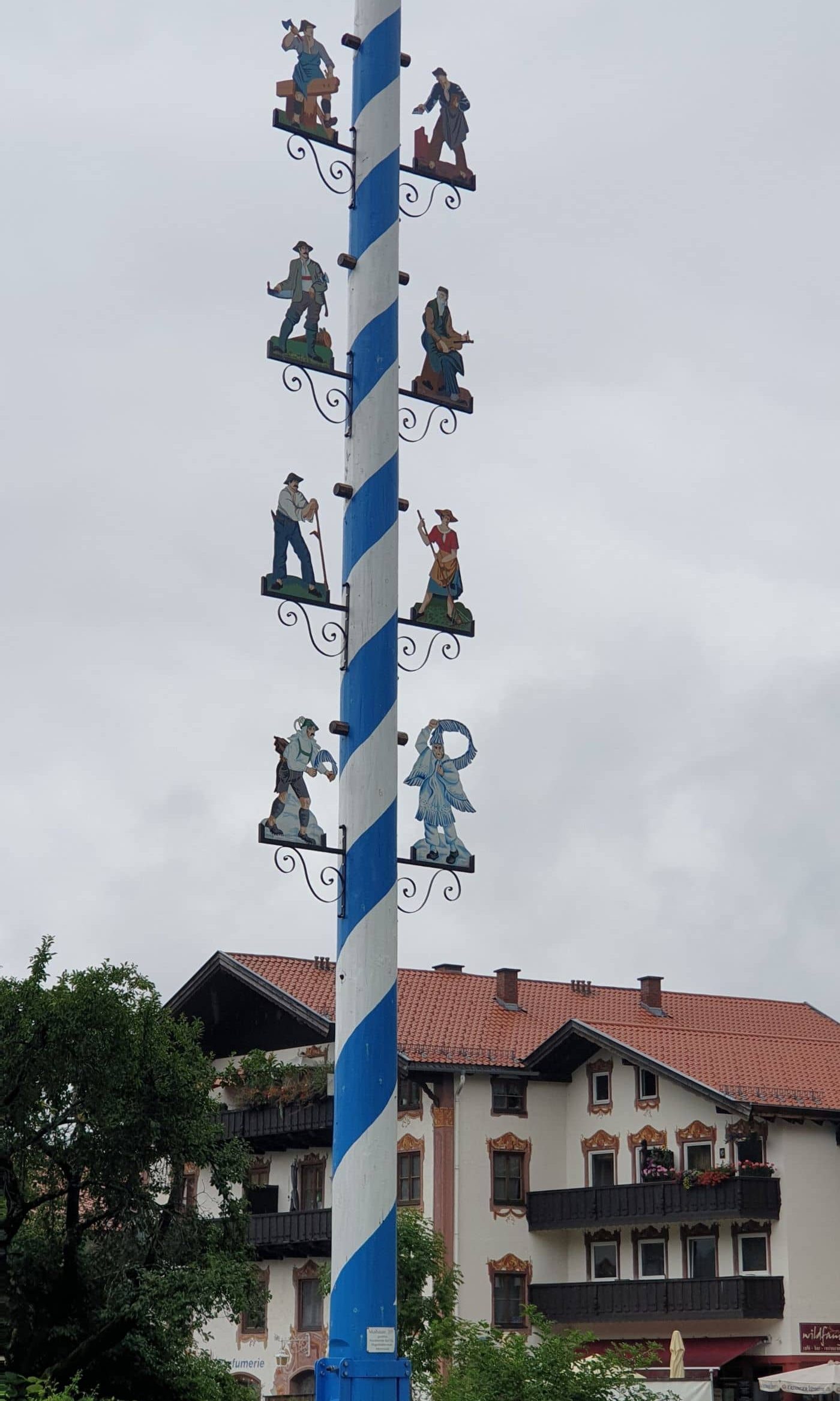

AI / ML – history, evolution, application and career prospects
Artificial Intelligence and Machine Learning (AI / ML) is a field of modern computing which has seen meteoric rise during

AI / ML – history, evolution, application and career prospects
Artificial Intelligence and Machine Learning (AI / ML) is a field of modern computing which has seen meteoric rise during the past decade. From being just another fantasy jargon in robotic sci-fi movies, AI / ML is now finding application in areas which cut across all kinds of businesses. Growth in demand for AI / ML professionals has inevitably led to more job options and opportunities for start-ups.
So, what is AI / ML? What does it take to make a career in this domain? What is the secret mantra to concoct an idea for a high-performing AI / ML start-up? Read on to understand the evolution of AI / ML and how it can benefit you.
History of AI / ML
It all began during World War II. By 1941, German military was advancing almost unchallenged, bombing areas deep within the English heartland. The Allied forces were staring at imminent defeat at the hands of the German blitzkrieg. At the core of German success was the ‘Enigma’ machine – a machine capable of generating such encrypted messages, that no human could intercept and decipher them. No human, until mathematician Alan Turing designed a machine to break the Enigma code. With the help of Turing’s machine, intelligence teams were able to predict the enemy’s moves far more accurately. Eventually, by the fall of 1945, the allies successfully turned the tables on axis powers and won the war.
Turing continued his research after the war and went on to develop the famous ‘Turing test’. This simple test forms the basis of machine learning as we know it today. Turing test is conducted by a human ‘judge’ who compares answers to a given problem from a machine and another human. The machine passes the Turing test if the judge is unable to distinguish between the human answer and machine’s answer.
Alan Turing proved that logic-based machines can display human-like intelligence. His seminal work changed our perception of algorithms forever.
Turing’s findings inspired many other researchers – mostly in cryptology and science institutes. Soon, John McCarthy, an American computer scientist proposed a conference calling together the machine learning intellectuals of his time. In 1956, eleven mathematicians and scientists in the conference at Dartmouth College formed the basis of Artificial Intelligence. McCarthy went on to be known as the father of AI.
Are AI and ML different?
Although often used interchangeably, AI is different from ML. Machine Learning focusses on mathematical modelling and pattern recognition to perform specific tasks (such as breaking military code). For instance, self-driving module of a car can be an example of an ML-based system.
Artificial Intelligence, on the other hand, leverages the power of ML to mimic human cognitive abilities and solve more complex problems. For instance, AI-based voice assistants like Alexa, Bixby or Siri on your phone can perform multiple tasks such as voice recognition, song recommendation, text to speech and appointment handling – just to name a few. While AI systems are like all-rounders, ML systems are often designed to be specialists.
What made AI / ML mainstream?
You may be wondering why is it that the demand for AI / ML has risen only recently, despite being researched since more than seventy years ago? Well, until the 1980s, AI / ML was confined to the laboratories of educational and research institutes. Owning a personal computer was a luxury back then. But in 1981, the IBM PC was launched, and this changed everything. For the first time it was possible to run complex algorithms with millions of instructions on affordable machines.
Telecom revolution
Within the first decade of the 21st century, telecommunication revolution connected millions of people with one another. Riding on the social media wave, Web 2.0 enabled people-generated data and replaced static websites. Over the past decade, billions of IoT devices (‘Internet of Things’ – enabled devices such as smart lights, smart meters, etc.) got connected to the web and began recording trillions of data points. Hardware manufacturers went into a frenzied race for higher computing power packed into smaller spaces with lower price tags. Large tech companies leveraged the power of the telecommunication boom and advanced cloud computing as a scalable and affordable alternative to owning server assets. It is no coincidence that the three largest cloud computing platforms are owned by technology companies Amazon, Google, and Microsoft. It’s all related to AI / ML.
Your phone has at least a thousand times more computing power than the 1969 Apollo spacecraft which carried man to the moon.
IoT and big data
Without even realizing it, we generate enormous amounts of data on apps, websites, and social media platforms. Every click, every conversation, every transaction that you make on your device gets recorded somewhere on the cloud. Similarly, IoT devices continuously stream data from sensors and cameras to the cloud. The sheer volume of data came with its own set of challenges – How to analyse this enormous data? How to visualize the data? And most importantly, how to use this data to make better business decisions?
As a result, ‘Big Data Analytics’ was born. New visualization tools such Power BI and Tableau were created. But nothing outshined the benefit that AI / ML had to offer.
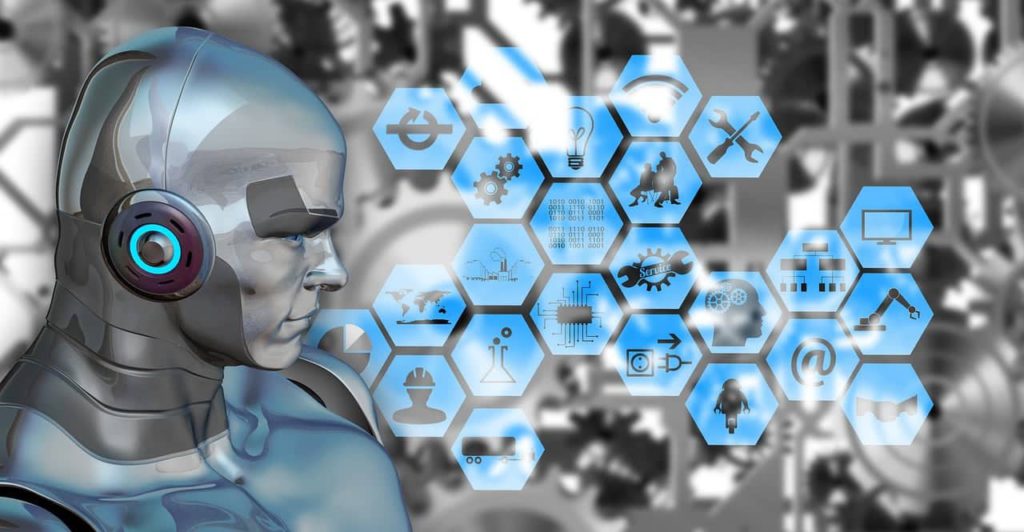
How does AI / ML work?
A machine learning algorithm works on identifying patterns in data based on statistical analysis. It is much like how children learn the alphabet for instance. You show the kid pictures of ‘A for Apple’, ‘B for Ball’ and keep adding verbal cues at each alphabet. In time, the child associates each alphabet with specific sounds. Eventually the child would be able to correctly recite the alphabet without any help. Similarly, a machine can be programmed (usually in Python code) to identify patterns in training data and form a statistical model for the output. This mathematical model can be tested with the help of a ‘test data set’. If the model holds good, it can be deployed suitably in microcontrollers (mainly for IoT devices) and / or apps. As more and more data flows in, the model gets better and better at recognizing statistical patterns and predicting the output.
For instance, let us take the example of your YouTube feed. As you watch more and more content on YouTube, the backend algorithm gets better at predicting your choices and recommending you relevant content. The input variables can be type of videos watched, watch duration, engagement (likes, comments, etc.). These input variables are fed into the statistical model which gives output pinpointing the best and most relevant content from millions of videos. The output of a machine learning algorithm is usually a block of code called the model or the ‘pickle’. This is just a simplified explanation and if the curious reader wishes to indulge deeper, the author recommends getting in touch for a guided tour of the AI / ML world.
Opportunities for employment in AI / ML
AI / ML practitioners typically start their career as Data Analysts or Jr. Data Scientists. As you may be aware, Data Scientist profiles are currently selling like hot cakes as the opening salaries for a fresh candidate is usually upwards of INR. 6 Lacs per annum (Bangalore / Delhi location). If you venture to click on one advertisement or even mention machine learning in your online searches – expect to get bombarded with ads from coaching institutes promising to make you a Data Scientist in weeks. Unsuspecting jobseekers usually succumb to prospects of the magical 6 – figure salary – often without getting a deeper understanding on what skills they need to acquire and what is being offered by the coaching institutes.
There is a wide spectrum of institutes offering AI / ML courses – from IIMs right down to the neighbourhood tuition centre. I would advise the job-seeking reader to evaluate freemium content on mass online platforms like coursera.org before any serious time / money investment.
Data Scientists are indeed in high demand. However, good ones are in short supply. Quick learners can make as high as INR. 20 Lacs in 3 – 5-year experience range. (Salary data was sourced from Glassdoor.com at the time of writing.)
Data Scientists must possess three main skillsets in their arsenal. Statistical thinking, understanding of business logic and command over python programming language. The job of a Data Scientist is to understand the business scenario first. Then they prepare the statistical model and implement the model in software code. Therefore, you should ideally pick a course which can teach you all these aspects in equal measure.
Opportunities for start-ups
According to NASSCOM there are more than 3,000 AI / ML-based start-ups in India (as of August 2022). Some of these start-ups work in the conversational AI space and provide chatbot-based applications. Others provide ML-based predictions to solve common customer problems. However, there are still loads of unexplored spaces where start-ups can capitalize on AI / ML to help improve businesses and people’s lives.
One such area is image recognition. Recently, a tech start-up has been able to use image recognition to ensure adherence to norms for the government’s sanitation drive. Their machine learning model has been designed to identify standard toilet layouts. All with washbasin and sanitaryware sizes as per the government specifications. The model can also classify clean versus dirty toilets. This helps the government to monitor the progress of toilet construction under ‘Swatch Bharat’. It also helps to incentivize or penalize contractors responsible for the maintenance and upkeep of those toilets.
Another innovative start-up is helping companies to screen candidates based on their facial expressions during interviews. As candidates appear for online interview, the algorithm rates their confidence level through expressions, vocal modulation, and the quality of their answers. This helps companies to screen the best candidates from thousands of job applicants – all without human intervention.
By the way you should read my article on Designing an innovative startup here
Conclusion
The field of AI / ML has achieved only a fraction of its true potential and there is far more ground to cover. In future, this field is expected to evolve much faster as 5G gets rolled out in next couple of years. Apparently, 5G will come with 20 times the speed of 4G and hence brings possibilities to leverage speedy online experience for users. There is also potential to marry AI / ML with newest technological advances such as Augmented Reality or Extended Reality and create something unique. In my opinion, the key to building a career in AI / ML is to build strong concepts in statistics even before learning to write python code – which trust me, is the easiest part.
Designing an innovative startup the M-I-T way
Some years ago, I took a course in innovation and commercialisation. This course helped me immensely to think about the
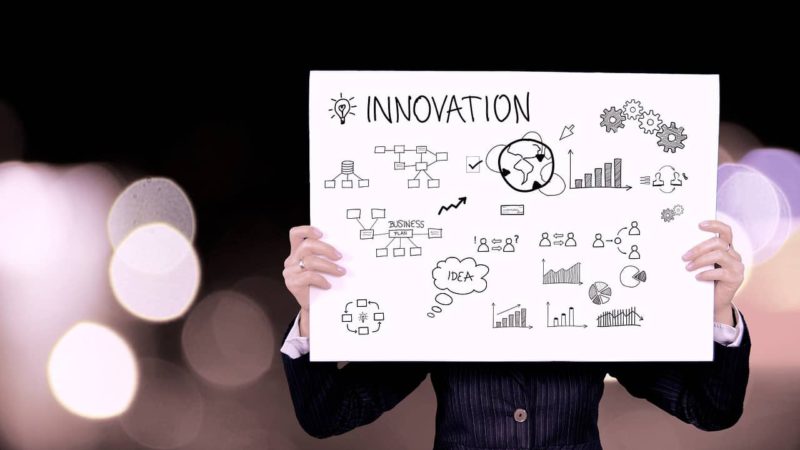
Designing an innovative startup the M-I-T way
Some years ago, I took a course in innovation and commercialisation. This course helped me immensely to think about the innovation process and how it can be used to build better designs for start-ups. So in this article, let me walk you through M-I-T (or MTI or whatever sequence you like) for designing an innovative startup.
What is innovation?
Innovation is the process of creating new ideas, products, or methods, or improving existing ones, in order to solve problems or meet new needs. It is an important aspect of business and economic growth. It allows companies to stay competitive and find new ways to meet the changing needs and preferences of customers. Innovation may involve the development of new technologies. It might mean introduction of new business models or processes. Implementation of new policies or practices also falls under innovation if they can generate additional revenue for the company. Innovation can also involve the combination of existing ideas or technologies in new and creative ways.

What is the difference between innovation and creativity?
Creativity is the ability to generate new and original ideas. On the other hand, innovation is the process of turning those ideas into something useful or valuable. Creativity is a crucial component of innovation. It provides the source material for new products, processes, or ways of doing things.
However, innovation involves more than just coming up with a new idea. It involves the development and implementation of that idea. Successful innovation often involves as the ability to effectively communicate and sell the idea to others.
Creativity is the spark that ignites the innovation process, while innovation is the fuel that powers it forward. Both are important for driving progress and finding solutions to problems. But they serve different roles in the process.
Good time for designing an innovative startup in India
The start-up ecosystem in India is slowly and gradually picking up. Like every cloud has a silver lining, every crisis comes with an opportunity. The volatility of the job market due to recent mass layoffs by tech giants like Meta and Twitter (and recently Google) is expected to fuel and propel the start-up ecosystem much more.
At the same time, is estimated that more than 90% start-ups fail to gather momentum and make it big. However, the associated sense of achievement of creating something unique, to be one’s own boss and to be a source of income generation for others far outweighs the risk of failure. The author himself has failed on a couple of occasions but the drive to keep trying hasn’t diminished one bit. 🙂
The M-I-T of innovation
M-I-T of innovation refers to Market, Implementation and Technology. Innovative start-ups require three main ingredients to thrive – Market, Technology, and Implementation. They are the core important considerations during the innovation process.
Market
The market refers to the target audience or customers for the innovation. Understanding the needs, preferences, and behaviours of the market is essential for creating products or services that will be successful.
Your product or service must address a critical problem and people should be willing to pay for the solution of that problem. In other words, there must be a ‘Market’ which is willing to buy your product or service.
Sometimes companies even create new markets or market needs. For instance, the iPod was a product without any apparent market need. Sony Walkman was doing just fine. However, Apple created the market by offering a sleek, good-looking audio player that could fit comfortably in the jeans pocket and play thousands of songs without having to change cassettes or CDs.
AI based content creators like ChatGPT and Hypotenuse.ai are latest innovations which have carved out a new market recently.
Similarly, the start-up you want to build should address a Market. Key questions that you may want to think about are –
- What common problems you can solve?
- What market need can you create?
- Will your solution enhance productivity or efficiency?
- Will it save money for people, corporates or governments?
- Who are the stakeholders?
- Which stakeholders are willing to pay?
These are some of the questions you should be contemplating – even before dwelling into the Technology part.
Technology
Now that you have identified the problem, think about what technology do you have at your disposal to solve that problem. Technology refers to the tools, techniques, and processes used to create the innovation. Advances in technology can often enable new innovations, and the development of new technologies can also be a source of innovation.
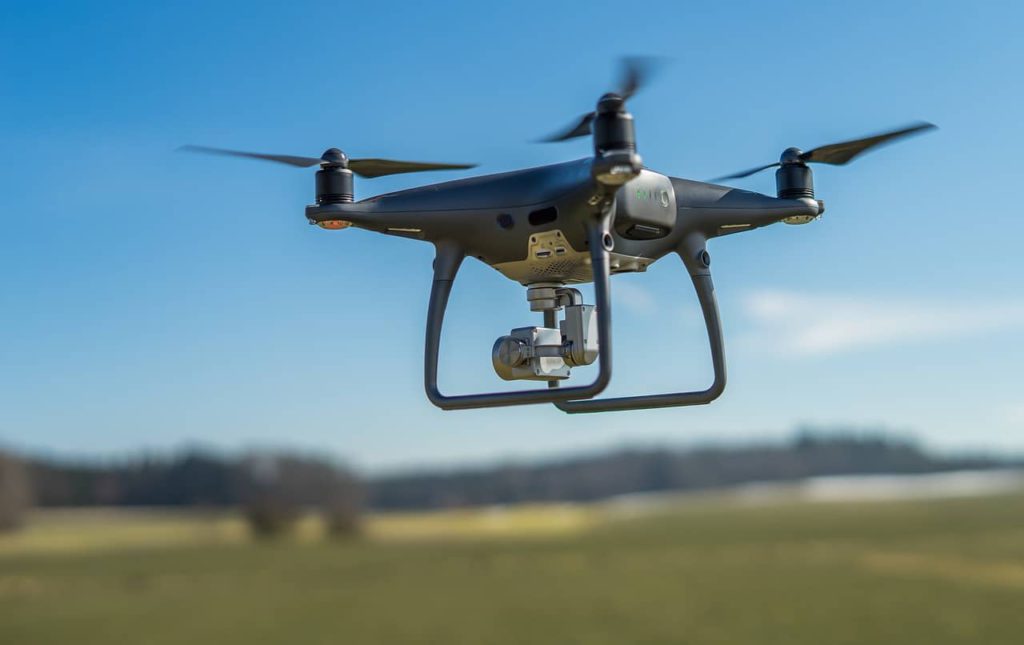
In terms of technology, key questions that you may want to think about are –
- What kinds of technological platforms are available to address the market?
- Is it possible to address the market through new technologies?
- What are the emerging trends and breakthroughs to address the market?
- Is it possible to enhance the user experience through your technology piece?
- Can all the technology costs be recovered from your users?
- Are there going to be any major changes in technology soon?
- What do the tech pundits say? Is the technology here to stay?
For instance, for an App-based setup, think about the user experience – what framework would suit the reliability and scalability needs? Do you want to stick to native (say Android only) or go cross-platform (support iOS, Android, web, etc.)? It is also important to consider the backend services and associated costs.
Implementation
Implementation involves the development and rollout of the innovation. This includes designing and testing prototypes, as well as developing a plan for how the innovation will be produced and delivered to the market. It is important to have an implementation plan in mind. But sort out the market and technology part first before you start diving into the action plans. This will save you a ton of trouble.
If your market and technology assessment are correctly done, implementation shouldn’t be much of a headache. Yet this is the phase where most startups don’t get it right and fail. Your implementation of a business model may be different from that of a competitor. For instance, look at Ola, Uber and In-Drive – all three address the same market. All three use the same technology. Yet they differ slightly in implementation and offer different customer experiences and price points for the same kind of service.
In terms of implementation, here are a few questions you can ponder upon –
- Is there a better way of serving the customers?
- What causes customer delight?
- What are the non-value adding activities in the process?
- How can cost be minimized without compromising customer experience?
- How to reshape the existing business model?
How to nurture innovation
Innovation is crucial for businesses to stay competitive and thrive in today’s fast-paced, constantly-evolving world. You need to design your startup to nurture innovation right from the word go. However, nurturing a culture of innovation within an organization is not always easy. It requires a dedicated effort and the right set of conditions to be in place. Here are some key ways to nurture innovation in your upcoming start-up:
Encourage a growth mindset
Encourage employees to embrace challenges and see them as opportunities for growth, rather than as threats. This can be fostered through training and development programs, as well as through leadership that models a growth mindset.
Innovation is the fuel for growth. When a company runs out of innovation, it runs out of growth.
Gary Hammel, London Business School
Foster collaboration and idea-sharing
Encourage open communication and collaboration among team members, and create channels for employees to share ideas and give feedback. This can be done through regular team meetings, suggestion boxes, and other feedback mechanisms.
Provide resources and support
Give your employees / team members the tools and resources they need to turn their ideas into reality. This might include funding for research and development, access to training and development opportunities, or support from leadership.
Encourage risk-taking
Innovation often requires taking calculated risks. Encourage employees to take risks and embrace failure as a learning opportunity.
If the size of your failures isn’t growing, you’re not going to be inventing at a size that can actually move the needle.
Jeff Bezoz, CEO – Amazon
Foster a culture of continuous learning
Encourage employees to stay up-to-date on industry trends and best practices, and to be open to learning new skills and knowledge. This can be done through training programs, workshops, and other learning opportunities.
Celebrate and reward innovation
Show appreciation for employees’ innovative ideas and efforts, and consider implementing a rewards or recognition program to incentivize innovation.
By implementing these strategies, organisations can create a culture that values and encourages innovation, leading to a more dynamic and successful business.
Conclusion
Together, these three factors – market, implementation, and technology – play important roles in the success of designing an innovative startup. These are the building blocks of future-ready ideas. It is also fruitful to nurture innovation early on during the design stage of your startup. Therefore, it is important to be mindful of these aspects and prepare adequately even before you jump into pitching your breakthrough idea. And for that – I wish you all the best!
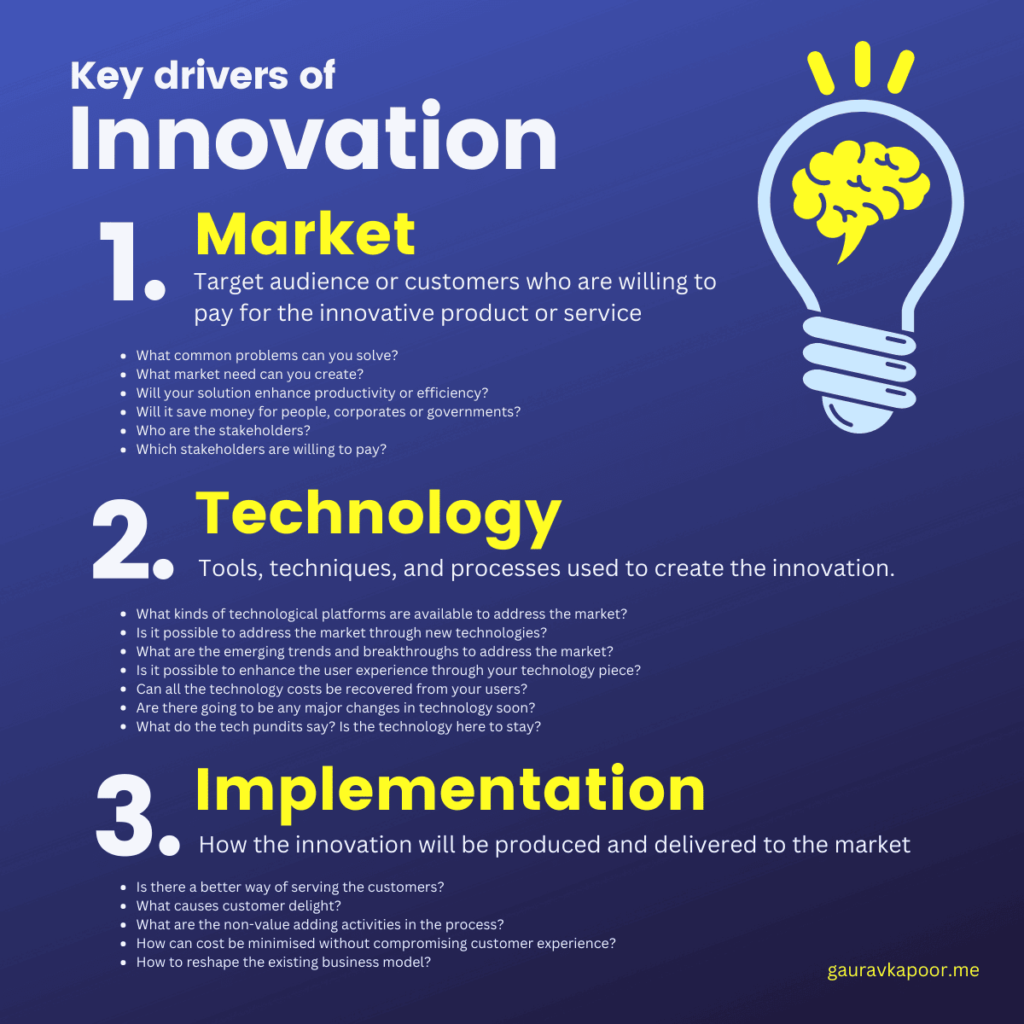
The sound of music tour, Salzburg
Salzburg is a city in Austria, located on the border with Germany. It is the capital of the state of

The sound of music tour, Salzburg
Salzburg is a city in Austria, located on the border with Germany. It is the capital of the state of Salzburg and is known for its beautiful Alpine setting, as well as its rich cultural and musical history. Salzburg is the birthplace of Wolfgang Amadeus Mozart and was the setting for the film “The Sound of Music.” The city is home to several universities and a thriving tourism industry, with many visitors coming to see its historic sites and beautiful natural surroundings. Salzburg is a popular destination for skiing and other winter sports, as well as for hiking and mountain climbing in the summer months.
Sound of Music – the movie
The Sound of Music is a musical with music by Richard Rodgers, lyrics by Oscar Hammerstein II, and a book by Howard Lindsay and Russel Crouse. It is based on the memoir of Maria von Trapp, The Story of the Trapp Family Singers. Set in Austria on the eve of the Anschluss in 1938, the musical tells the story of Maria, who becomes a governess to the seven children of Captain Georg von Trapp. The story is based on the real-life von Trapp family, who escaped from Austria to the United States in 1938 to avoid Nazi persecution. The musical features classic songs such as “Do-Re-Mi,” “Edelweiss,” and “Climb Ev’ry Mountain.” The original Broadway production opened in 1959 and the film adaptation was released in 1965, starring Julie Andrews and Christopher Plummer. The movie is has won five Academy Awards, including Best Picture
Sound of music tours in Salzburg
There are several “Sound of Music” tours available in Salzburg that allow visitors to explore the city and visit some of the locations where the movie was filmed. These tours typically include visits to landmarks such as the Mirabell Palace and Gardens, which were featured in the movie, as well as other iconic locations such as the Nonnberg Abbey and the Salzburg Cathedral. Some tours also include a visit to the von Trapp family’s home, which is now a museum. The tours usually last for several hours and are led by guides who are knowledgeable about the film and the city’s history. Many people enjoy taking a “Sound of Music” tour when visiting Salzburg because it allows them to learn more about the movie and see some of the beautiful locations where it was filmed.







